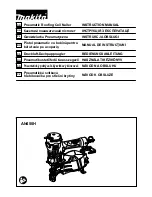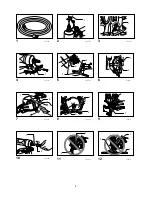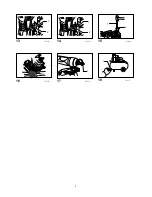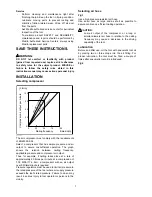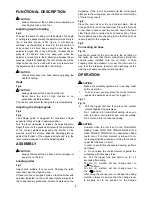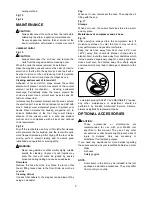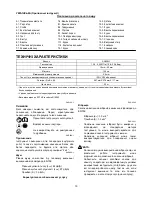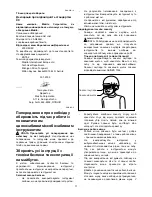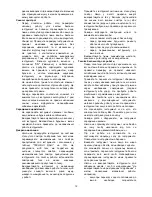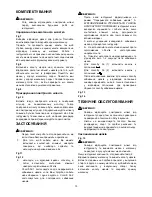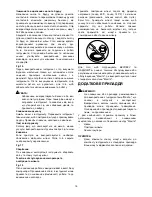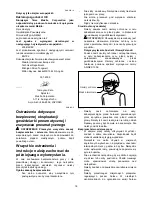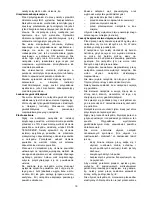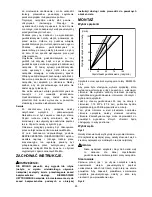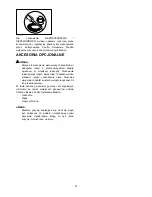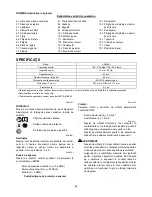
9
nailing method.
Fig.13
Fig.14
MAINTENANCE
CAUTION:
•
Always disconnect the air hose from the tool before
attempting to perform inspection or maintenance.
•
Never use gasoline, benzine, thinner, alcohol or the
like. Discoloration, deformation or cracks may result.
Jammed nailer
Fig.15
CAUTION:
•
Always disconnect the air hose and remove the
nails from the magazine before cleaning a jam.
When the nailer becomes jammed, do as follows:
Open the magazine cap and remove the nail coil. Insert a
small rod or the like into the ejection port and tap it with a
hammer to drive out the nail jamming from the ejection
port. Reset the nail coil and close the magazine cap.
Cleaning and removal of tar and dirt
Adhesion of tar and dirt to areas around the contact
element will prevent smooth movement of the contact
element (safety mechanism), Causing accidental
discharge. Periodically clean the areas around the
contact element. Use a solvent such as keros ene, #2
fuel oil or diesel fuel.
Immerse only the contact element and the areas around
the ejection port in solvent and remove tar and dirt with
brush. Always wear waterproof gloves to protect your
hands. Never immerse the housing, magazine, etc. in
solvent. Malfunction of the tool may result. Always
dispose of the solvent used in a safe and prudent
manner and in compliance with all local and national
code requirement.
Fig.16
Dry off the tool before use. Any oil film left after cleanup
will accelerate the tar buildup, and the tool will require
more frequent recleaning. After drying off the tool, oil the
moving parts to prevent rusting and to assure good
lubrication and operation or moving parts.
WARNING:
•
Never use gasoline or other similar highly volatile
liquids for cleaning. Vapors of such liquids may
enter the tool and could be ignited by sparks
produced during nailing and cause an explosion.
Drain tool
Remove the hose from the tool. Place the tool so that
the air fitting faces down to the floor. Drain as much as
possible.
Cleaning of tool
Iron dust that adhere to the magnet can be blown off by
using an air duster.
Cap
When not in use, disconnect the hose. Then cap the air
fitting with the cap.
Fig.17
Storage
When not in use, the nailer should be stored in a warm
and dry place.
Maintenance of compressor and air hose
Fig.18
After operation, always drain the compressor tank. If
moisture is allowed to enter the tool, It may result in
poor performance and possible tool failure.
Keep the air hose away from heat (over 60°C, over
140°F), away from chemicals (thinner, strong acids or
alkalis). Also, route the hose away from obstacles which
it may become dangerously caught on during operation.
Hoses must also be directed away from sharp edges
and areas which may lead to damage or abrasion to the
hose.
Stove
Thinner
004320
To maintain product SAFETY and RELIABILITY, repairs,
any other maintenance or adjustment should be
performed by Makita Authorized Service Centers,
always using Makita replacement parts.
OPTIONAL ACCESSORIES
CAUTION:
•
These accessories or attachments are
recommended for use with your Makita tool
specified in this manual. The use of any other
accessories or attachments might present a risk of
injury to persons. Only use accessory or
attachment for its stated purpose.
If you need any assistance for more details regarding
these accessories, ask your local Makita Service Center.
•
Nails
•
Air hoses
•
Safety goggles
NOTE:
•
Some items in the list may be included in the tool
package as standard accessories. They may differ
from country to country.
Содержание AN450H
Страница 3: ...3 1 2 13 009535 1 2 14 009536 1 2 15 009539 16 009545 1 17 009587 1 18 004317 ...
Страница 58: ...58 ...
Страница 59: ...59 ...
Страница 60: ...60 Makita Corporation Anjo Aichi Japan www makita com 884859C974 ...

